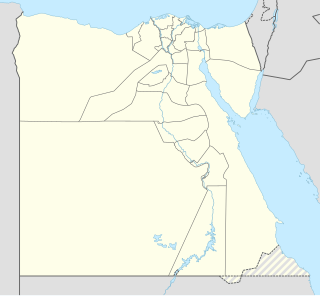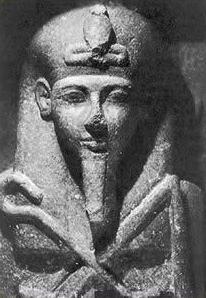
Tomb KV5 is a subterranean, rock-cut tomb in the Valley of the Kings. It belonged to the sons of Ramesses II. Though KV5 was partially excavated as early as 1825, its true extent was discovered in 1995 by Kent R. Weeks and his exploration team. The tomb is now known to be the largest in the Valley of the Kings. Weeks' discovery is widely considered the most dramatic in the valley since the discovery of the tomb of Tutankhamun in 1922.

Seti II was the fifth pharaoh of the Nineteenth Dynasty of Egypt and reigned from c. 1203 BC to 1197 BC. His throne name, Userkheperure Setepenre, means "Powerful are the manifestations of Re, the chosen one of Re." He was the son of Merneptah and Isetnofret II and sat on the throne during a period known for dynastic intrigue and short reigns, and his rule was no different. Seti II had to deal with many serious plots, most significantly the accession of a rival king named Amenmesse, possibly a half brother, who seized control over Thebes and Nubia in Upper Egypt during his second to fourth regnal years.

Amenmesse was the fifth pharaoh of the Nineteenth Dynasty in Ancient Egypt, possibly the son of Merneptah and Queen Takhat. Others consider him to be one of the innumerable sons of Ramesses II. Very little is known about this pharaoh, who ruled Egypt for only three to four years. Various Egyptologists date his reign between 1202 BC–1199 BC or 1203 BC–1200 BC with others giving an accession date of 1200 BC. Amenmesse means "born of or fashioned by Amun" in Egyptian. Additionally, his nomen can be found with the epithet Heqa-waset, which means "Ruler of Thebes". His royal name was Menmire Setepenre.
Kent R. Weeks is an American Egyptologist.

Tomb KV60 in Egypt's Valley of the Kings is one of the more perplexing tombs of the Theban Necropolis, due to the uncertainty over the identity of one female mummy found there (KV60A), thought by some, such as the noted Egyptologist Elizabeth Thomas, to be that of the Eighteenth Dynasty pharaoh Hatshepsut. This identification has been advocated by Egyptologist Zahi Hawass.

Tomb KV19, located in a side branch of Egypt's Valley of the Kings, was intended as the burial place of Prince Ramesses Sethherkhepshef, better known as Pharaoh Ramesses VIII, but was later used for the burial of Prince Mentuherkhepshef instead, the son of Ramesses IX, who predeceased his father.

Tomb KV11 is the tomb of Ancient Egyptian Pharaoh Ramesses III. Located in the main valley of the Valley of the Kings, the tomb was originally started by Setnakhte, but abandoned when it broke into the earlier tomb of Amenmesse (KV10). Setnakhte was buried in KV14. The tomb KV11 was restarted and extended and on a different axis for Ramesses III.

Akhenre Setepenre Siptah or Merenptah Siptah was the penultimate ruler of the Nineteenth Dynasty of Egypt. His father's identity is currently unknown. Both Seti II and Amenmesse have been suggested although the fact that Siptah later changed his royal name or nomen to Merneptah Siptah after his Year 2 suggests rather that his father was Merneptah. If correct, this would make Siptah and Seti II half-brothers since both of them were sons of Merneptah.

James Burton was an early British Egyptologist, known for his pioneering exploration and mapping of the Valley of the Kings, during which he became the first individual of the modern age to enter KV5; his pioneering excavations at Karnak, during which he discovered the Karnak king list; and his excavations at Medinet Habu, during which he was part of the team that discovered TT391.

The area of the Valley of the Kings, in Luxor, Egypt, has been a major area of modern Egyptological exploration for the last two centuries. Before this, the area was a site for tourism in antiquity. This area illustrates the changes in the study of ancient Egypt. Starting as antiquity hunting, and ending as scientific excavation of the whole Theban Necropolis. Despite the exploration and investigation noted below, only eleven of the tombs have actually been completely recorded.

Tomb KV1, located in the Valley of the Kings in Egypt, was used for the burial of Pharaoh Ramesses VII of the Twentieth Dynasty. Although it has been open since antiquity, it was only properly investigated and cleared by Edwin Brock in 1984 and 1985. The single corridor tomb itself is located in Luxor's West Bank, and is small in comparison to other tombs of the twentieth dynasty.

Tomb KV10, located in the Valley of the Kings near the modern-day Egyptian city of Luxor, was cut and decorated for the burial of Pharaoh Amenmesse of the Nineteenth Dynasty of Ancient Egypt. However, there is no proof that he was actually buried here. Later, the decoration was replaced with scenes for Takhat and Baketwernel—two royal women dating to the late 20th dynasty.

Tomb KV15, located in the Valley of the Kings in Egypt, was used for the burial of Pharaoh Seti II of the Nineteenth Dynasty. The tomb was dug into the base of a near-vertical cliff face at the head of a wadi running south-west from the main part of the Valley of the Kings. It runs along a northwest-to-southeast axis, comprising a short entry corridor followed by three corridor segments which terminate in a well room that lacks a well, which was never dug. This then connects with a four-pillared hall and another stretch of corridor that was converted into a burial chamber.

Tomb KV40 is located in the Valley of the Kings, in Egypt. The original occupant of this tomb is unknown. Only the upper part of the shaft is accessible; the rest is filled with rubble, and nothing is known about the tomb's layout. Although the tomb was excavated by Victor Loret in 1899, no report was published.

Tomb KV50 is located in the Valley of the Kings, in Egypt. It contained the burial of a dog mummy and a mummified monkey, and is probably associated with the nearby tomb of Amenhotep II (KV35).
Otto John Schaden was an American Egyptologist. He was the field director of the Amenmesse Tomb Project of the University of Memphis (Tennessee). In addition to his work on the tomb of Amenmesse (KV10) in the main arm of the Valley of the Kings, he has also cleared and reinvestigated tombs WV23, WV24, and WV25 in the Western Valley.










